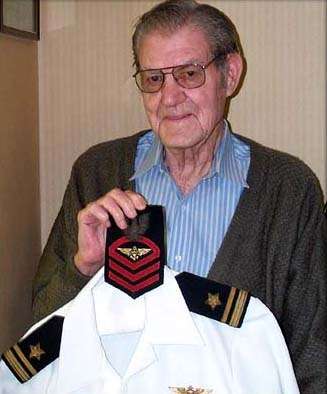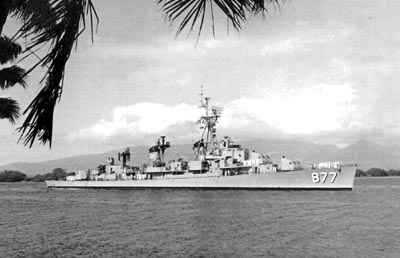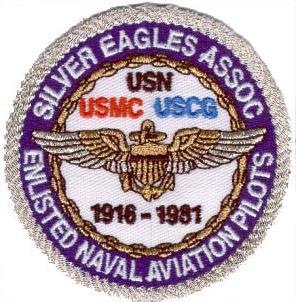Former Enlisted Man, Pilot, Recalls WWII Service
Richard Beaver is one of the last of a few. And at 84 years old,
he's an "endangered species" of the Silver Eagles -- the World War
II enlisted pilots of the sea services.
Speaking from Gulfport (MI), Beaver said age is irrelevant. "I
came here to the Armed Forces Retirement Home (formerly the Naval
Home) in 1991 when I was 72. People are supposed to be old at that
age, but I didn't feel old. I felt like I was about 40 or 50, and
there are people here at 60 who look like they're 120," Beaver said
with a hushed laugh.
When it comes to the retirement home, Beaver said, "You can't
find anything like it anywhere else for the price you've got. It
serves my purpose. It's great -- beautiful."

The Navy In 1938: "A Good Place To Go"
As a teenager, Beaver became frustrated and disappointed because
he couldn't find a job in the rural community of Fancy Creek
Township in Sangamon County (IL) near Springfield, the county seat.
Sangamon County, located in the heart of Illinois, was the home of
Abraham Lincoln, the nation's 16th president. Beaver was born there
on May 24, 1919.
The Navy beckoned, and Beaver took the oath of enlistment Sept.
11, 1938. "There (were) no jobs, so the Navy seemed like a good
place to go," said Beaver.
He became a machinist's mate, but he really wanted to fly combat
aircraft as a Navy pilot. Graduating from boot camp in San Diego in
December 1938, Beaver went aboard the destroyer USS
Perkins 377 and worked his way from the deck force to the
engine room, which he liked.
"I made seaman first class in three years -- before World War II
-- which was a pretty good deal," Beaver said proudly.
The Perkins sailed to Hawaii to join the Hawaiian
Detachment in September 1939, the month the Nazis invaded Poland;
Great Britain, France, Australia, New Zealand and Canada declared
war on Germany; the British Royal Air Force attacked the German
Navy; and the United States proclaimed neutrality.
Beaver said, at first, there was just a squadron of destroyers
and cruisers there, then on May 7, 1940, President Franklin D.
Roosevelt ordered the Pacific Fleet to Pearl Harbor.
When the Japanese attacked Pearl Harbor on Dec. 7, 1941, Beaver
was at the Navy yard on Mare Island, Vallejo (CA), near San
Francisco.
"We got underway immediately and made two convoy trips from San
Francisco to Pearl Harbor," Beaver noted. "We convoyed the first
expeditionary troops to the Pacific out of San Francisco."
Beaver was aboard when the Perkins was engaged in the
Battle of the Coral Sea and the Battle of Sydney Harbor
(Australia). The Perkins was involved in pivotal battles
around Guadalcanal and New Guinea, and earned four battle stars
during World War II. The only damage the Perkins received
while Beaver was a crewman were hits by shrapnel.

Beaver said he was lucky because he'd gotten off the destroyer
when a damaged propeller screw caused the ship to return to Pearl
Harbor from the South Pacific in August 1942. While repairs were
being made, Beaver used his liberty time to take civilian flying
lessons. His application for Navy flight school was approved before
the Perkins headed back to war.
"They wanted to make me a (chief petty officer) before I left
the ship for flight school, but I refused it because I wanted to
fly more," he said.
"I'd finished flight school – earned my wings – when
she (Perkins) was sunk in November 1943," Beaver noted. "I
was flying combat patrols then – what I'd always wanted to
do."
Ironically, the Perkins wasn't sunk by enemy fire; it
went down after being accidentally rammed by the Australian
transport HMAS Duntroon. The Duntroon's crew rescued most
of the Perkins crew. Some reports say one Perkins crewman died,
others reports say four perished.
"As soon as I got out of flight school, I went to San Diego for
assignment with the PT (Patrol Torpedo Boat) 72 patrol squadron
– 'the Knights of the Sea,'" Beaver noted. Operating out of
Funafuti in the Ellice Islands, he flew the "Black Cat" PBY
Catalinas, a squadron of black-painted aircraft that operated
mainly at night against enemy shipping.
"We did patrols out of there prior to the invasion of the
Central Pacific, the Gilberts, Marshalls and Enewetak islands,"
Beaver explained. "That took about a year, then we went through
Tarawa and Kwajalein, and we had planes in the Marianas during the
Marianas campaign. That took another year. Then we came back to the
states because our airplanes were worn out by then."
He said the invasion of Tarawa atoll is called one of the worst
and bloodiest battles the Marines had ever faced. "The reason was
the tide was supposed to be in, but by some phenomena of weather,
the tide was out," Beaver noted. "So the landing crafts couldn't
get close to the beach for the Marines and soldiers to get off.
They were about a mile out and tried to get to the beach in
waist-deep water. About 4,000 Japanese were on the island and
slaughtered the guys in the water."
After the war was over in 1945, he went to the Philippine island
of Samar, the site of the Battle Off Samar, for a short time. From
there he went to Guam, then back to the United States.
"I still hadn't been commissioned; I was still a chief petty
officer aviation pilot," Beaver said. "When I came back from that
tour of duty in the Pacific, they recommended us for commission
because you couldn't fly in a war zone as an enlisted pilot at that
time. So I became an ensign in '46 when I came back to Guam. That's
when I came back to the states and I took a discharge. I wanted to
get out.
The End Of The Silver Eagles
 "They discontinued the enlisted
pilot program in 1948, and the last one retired in 1981," he
explained. "Those that were already in were allowed to continued on
to retirement.
"They discontinued the enlisted
pilot program in 1948, and the last one retired in 1981," he
explained. "Those that were already in were allowed to continued on
to retirement.
"We were kind of a breed of our own, I guess," Beaver said.
"They called us 'Silver Eagles,' and three enlisted pilots who were
commissioned became admirals. So that's quite a history, which
we're proud of."
He noted that the Silver Eagles are featured in the National
Museum of Naval Aviation in Pensacola (FL).
In 1946, Beaver folded his aviator's wings and left the Navy,
but his absence didn't last long. He thought he was going to be one
of the first pilots for an upstart cargo company, but that didn't
work out. The company went bust and Beaver went back into the Navy
as an enlisted pilot.
"I didn't even try to go back into my commissioned status," said
Beaver, who retired in 1958 as a lieutenant since he'd served more
than two years as a commissioned officer.
Commissioned officers are ineligible to live at the retirement
home. Beaver qualified for residency because of his enlisted time
in the Navy.
The same week he retired, Beaver landed a job as an air traffic
controller with the Federal Aviation Administration's Air Traffic
Control Center at Chicago Midway Airport (IL). He also served as a
facility pilot, flying other controllers to Springfield, Ill., St.
Louis and Indianapolis.
"Midway Airport was the busiest airport in the world when I was
there," Beaver noted. "Shortly after I started working there, jets
came into service and O'Hare Airport (Chicago) became the
boomer."
From Midway, he went to the control tower in Springfield (IL).
From there, he went to Champaign, where he retired for the
second time at the age of 50. Beaver said he built his retirement
home on "millionaire's row" at Lake Taneycomo near Branson, Mo.
"Everybody that had retired was older than I was," he noted. "All I
did was fish and play golf for a year. This old gentleman who had a
real estate agency with offices in small towns throughout
southwestern Missouri said one day, 'Dick, why don't you do
something?'" Beaver said.
"He asked me, 'wouldn't you like to have something to do besides
play golf and fish?'" Beaver recalled. "And I asked him, 'Do what?
I've flown airplanes in these hills and you don't have anyplace to
land.'
"And he said, 'Sell real estate,'" Beaver said.
Beaver took him up on the offer, got his license and sold real
estate for more than 20 years.
"I branched off into commercial properties (the) last 10 years
– selling motels and hotels. I did that until shortly before
I came here in July 1991," he noted. "I was 72, divorced and living
by myself, so I came down here and I was in tip-top shape. But
since I've been here, I've gotten hurt in a softball game and have
a lumbar spinal stenosis."
Back At The Home...
Beaver said during his first six months at the retirement home,
he was thinking, "I'm 72 and these guys are a bunch of old grouches
around here. They always complained about everything. And I thought
what am I doing here with these critters. I felt like, this is
ridiculous."
Beaver said at the age of 83, his girlfriend is a year younger
than he. "We're just a couple old people that really hit it off as
good buddies and liked to dance," he noted. "She taught me the
Cajun dance, then I taught her the polka and foxtrot, and we did
some of the other dances."
His girlfriend, Clara Cross, had a stroke and can't dance
anymore. "People used to admire us dancing, because we could do
anything," said Beaver, adding that he visits her every day. "We'd
visit her mother, who was 103, in Lafayette (LA) before she
died.
 Aero-News: Quote of the Day (12.11.25)
Aero-News: Quote of the Day (12.11.25) ANN's Daily Aero-Term (12.11.25): Nonradar Arrival
ANN's Daily Aero-Term (12.11.25): Nonradar Arrival Classic Aero-TV: David Uhl and the Lofty Art of Aircraft Portraiture
Classic Aero-TV: David Uhl and the Lofty Art of Aircraft Portraiture Airborne-NextGen 12.09.25: Amazon Crash, China Rocket Accident, UAV Black Hawk
Airborne-NextGen 12.09.25: Amazon Crash, China Rocket Accident, UAV Black Hawk Airborne 12.05.25: Thunderbird Ejects, Lost Air india 737, Dynon Update
Airborne 12.05.25: Thunderbird Ejects, Lost Air india 737, Dynon Update





